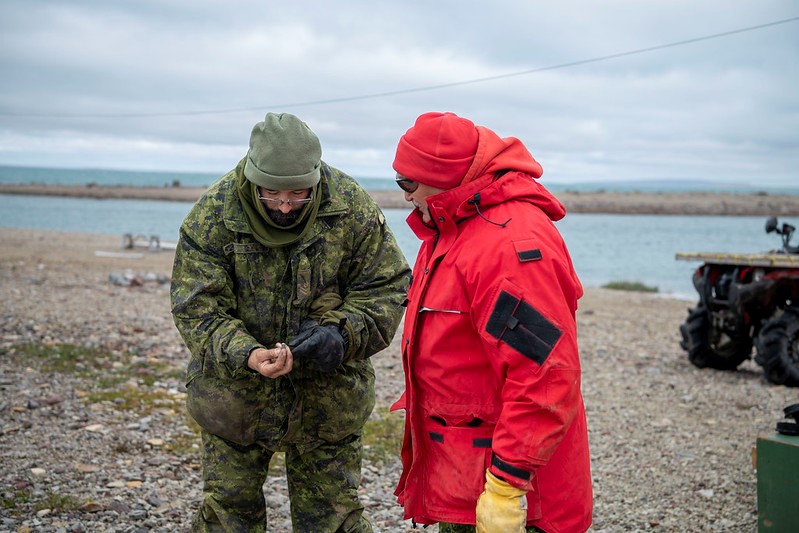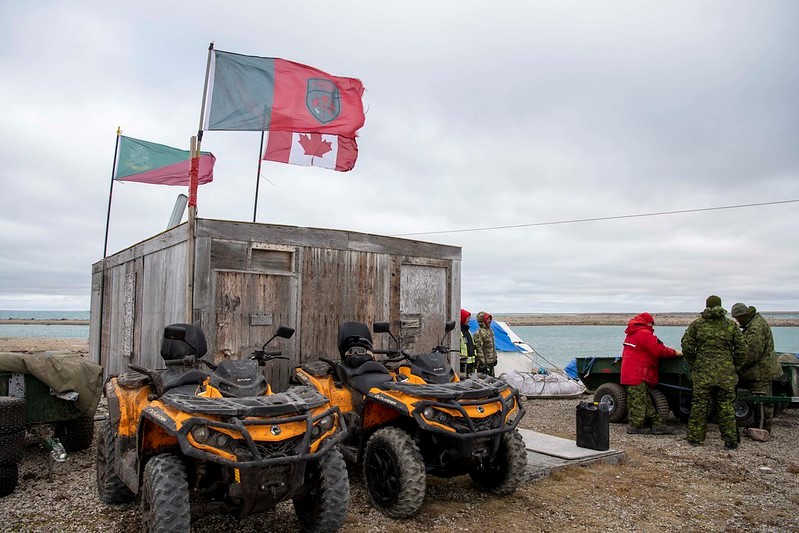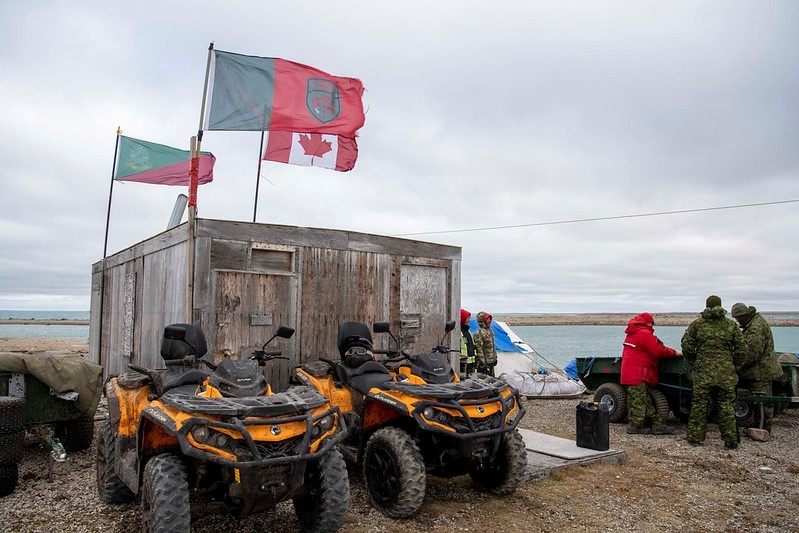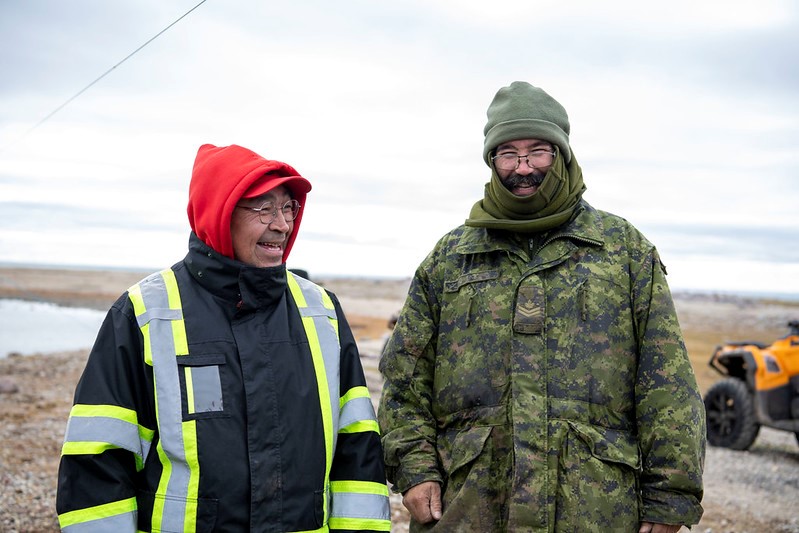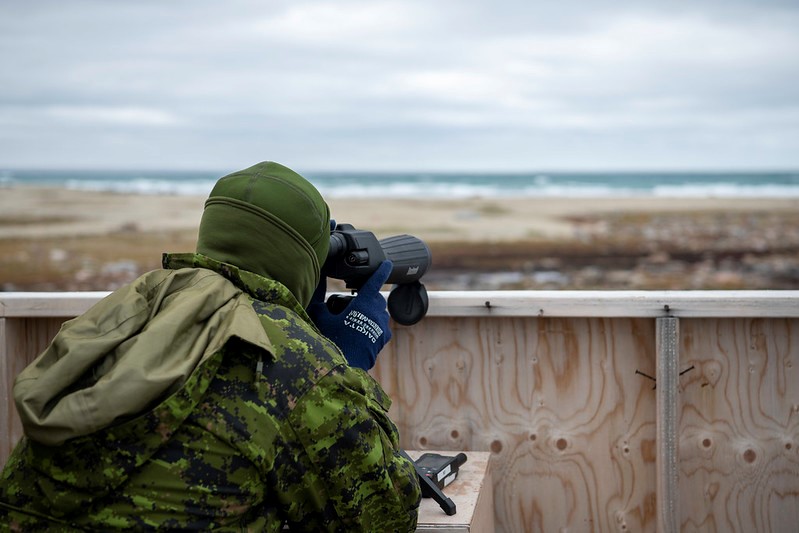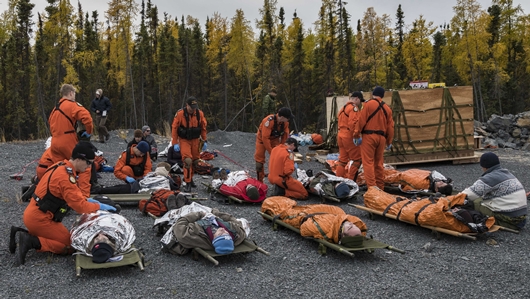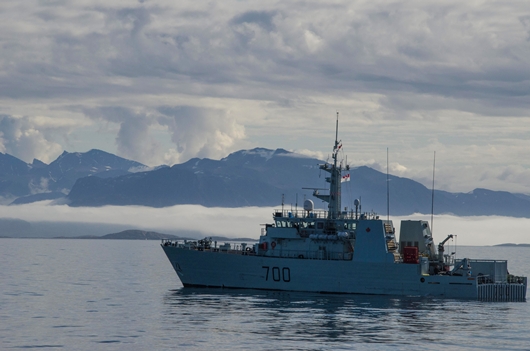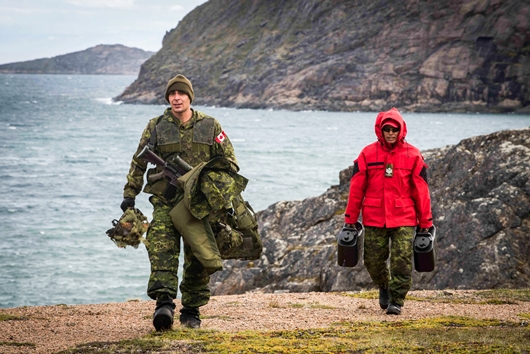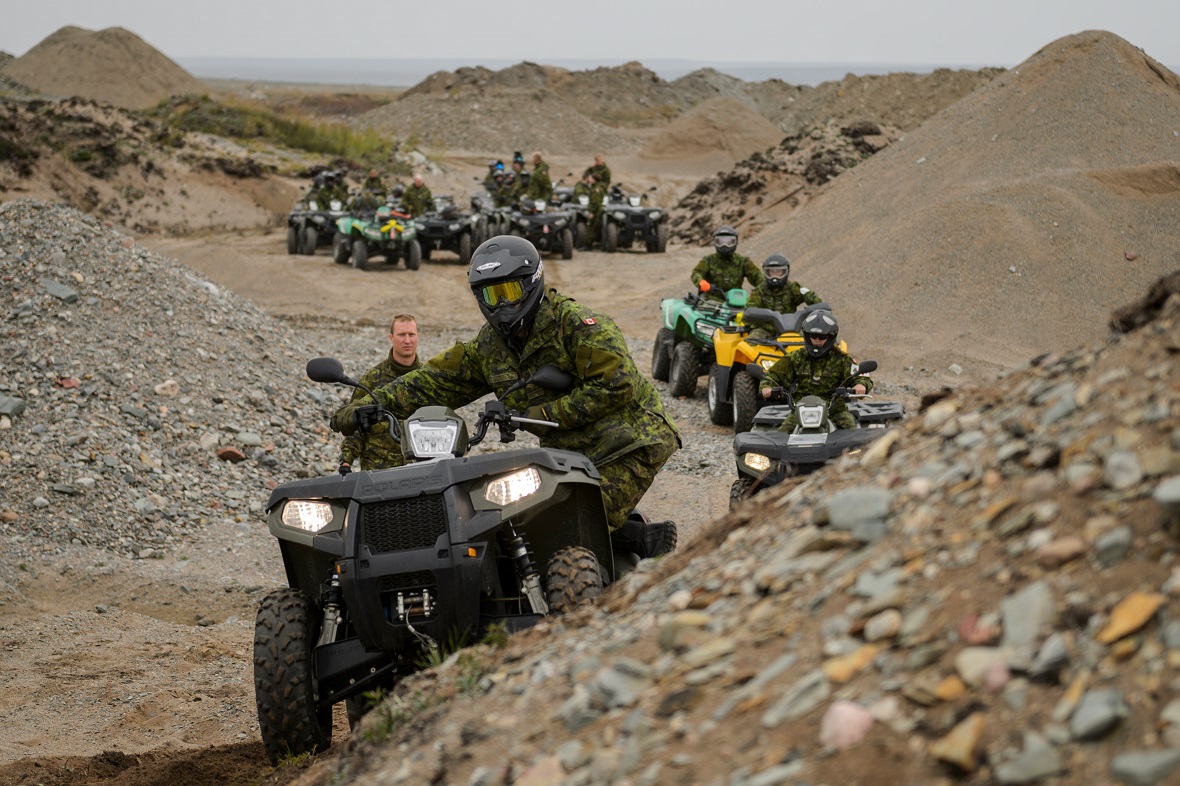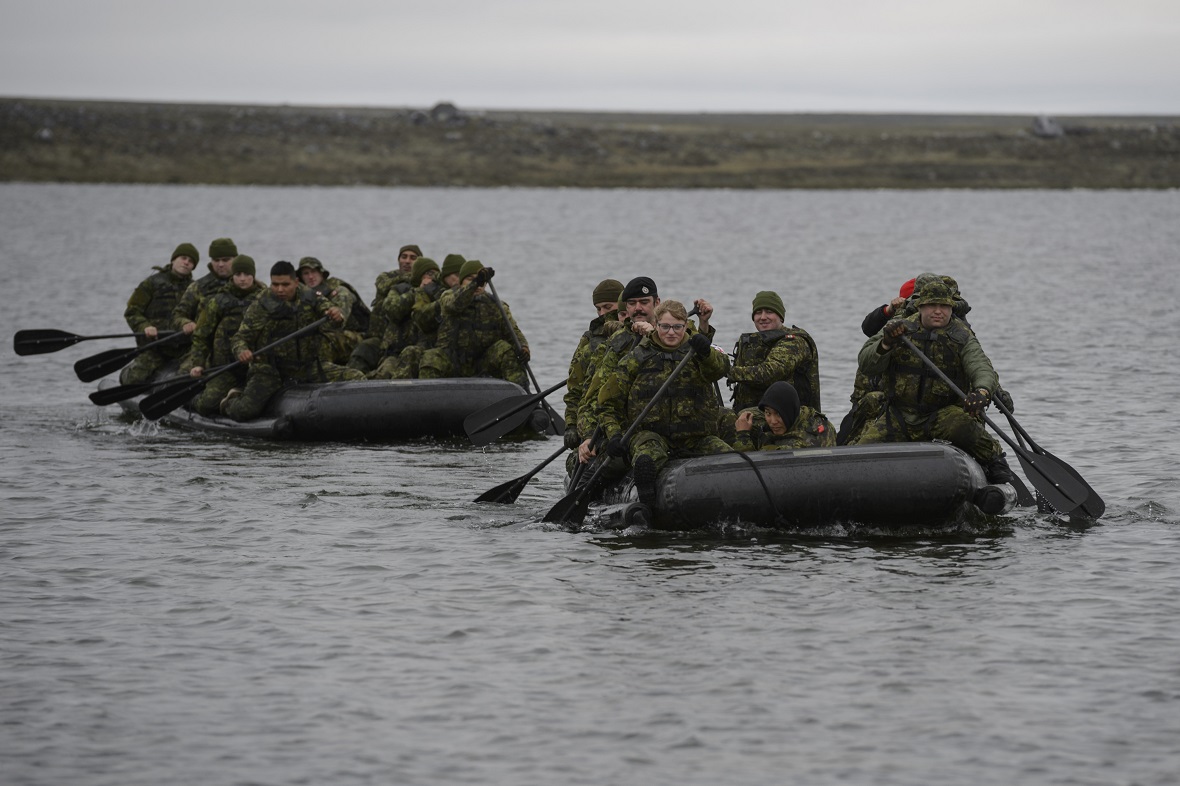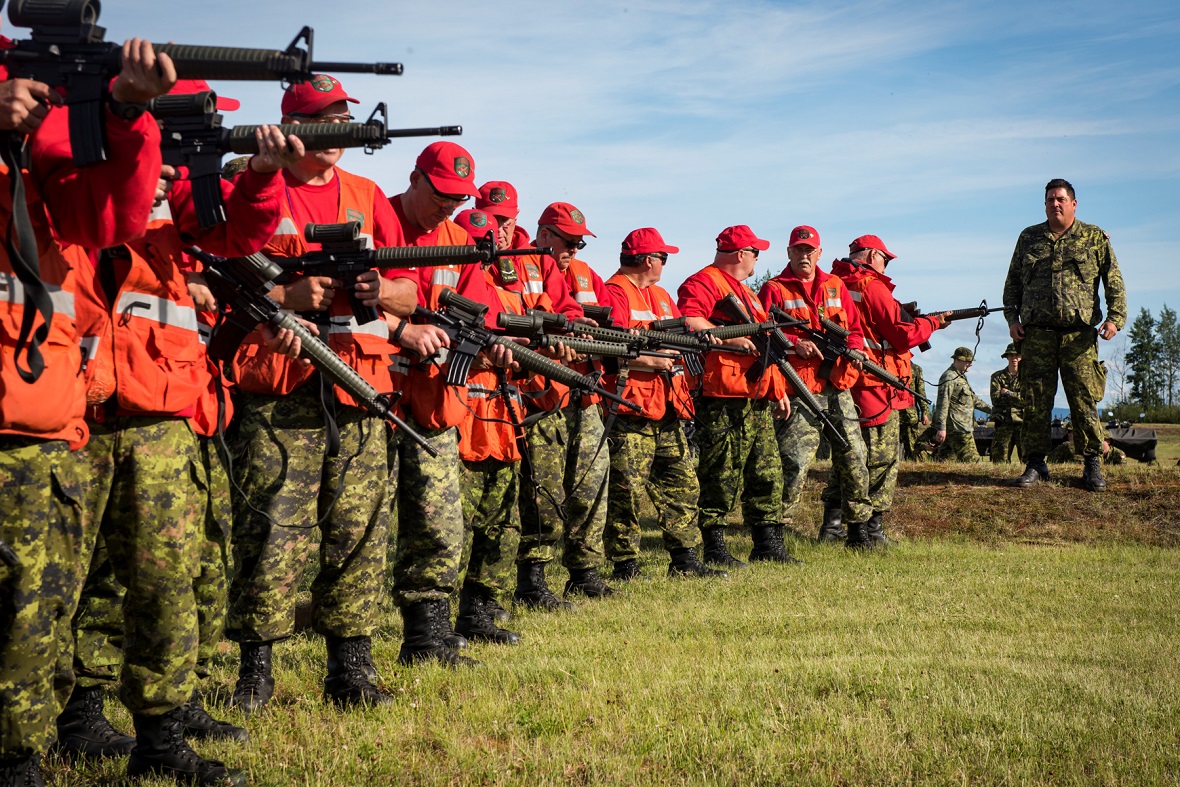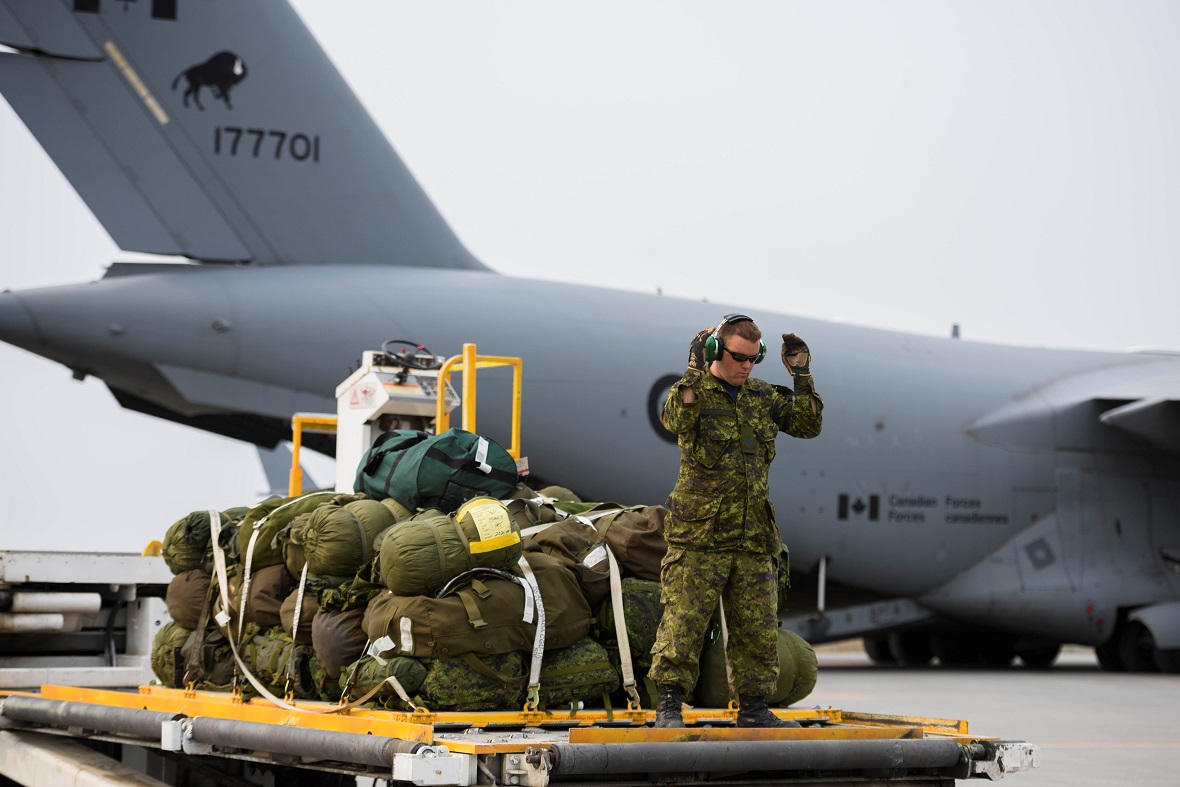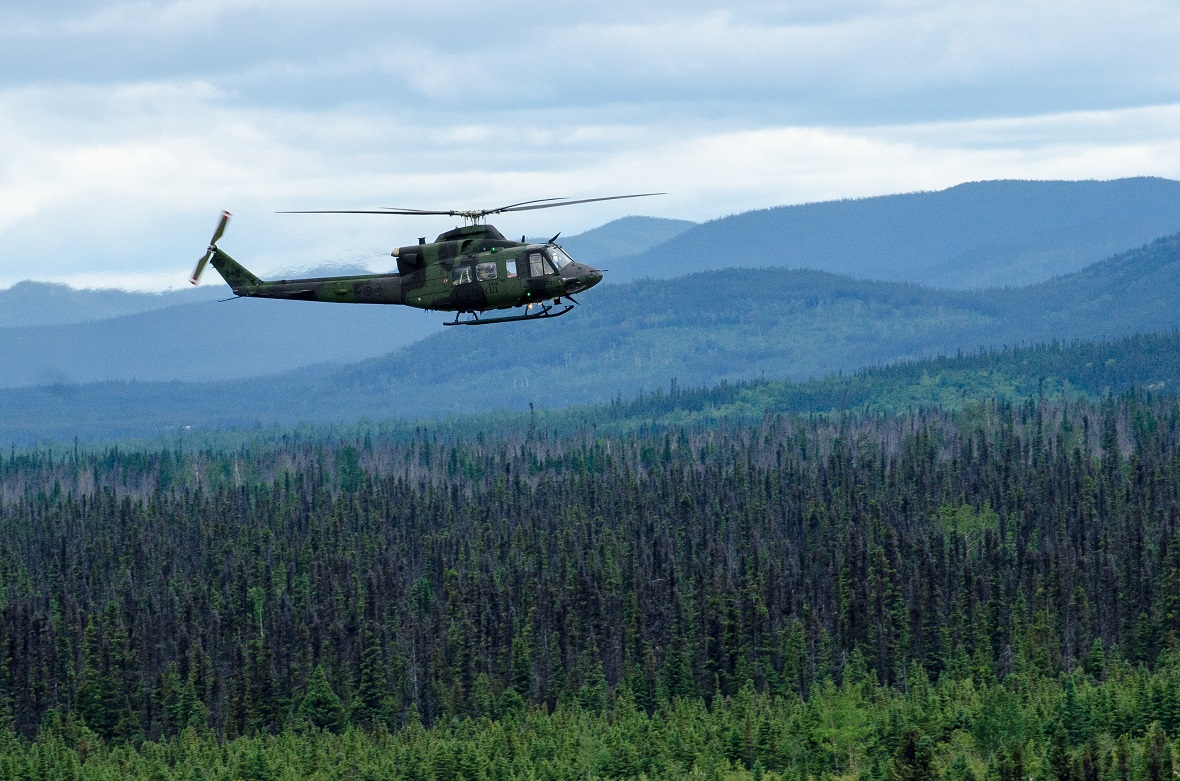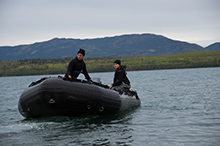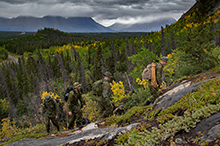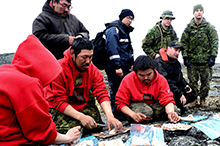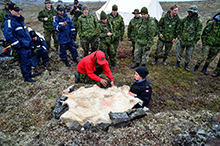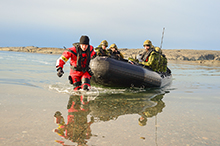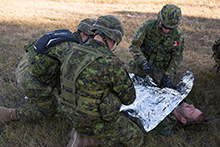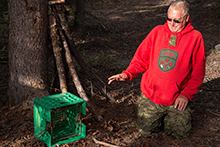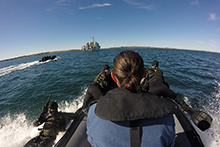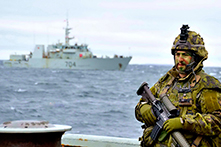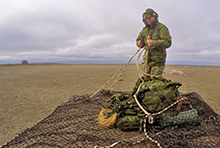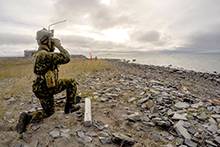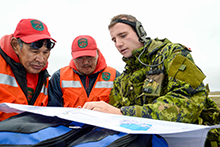Operation NANOOK
The Arctic All-Domain Planning Conference 2025
The Arctic All-Domain Planning Conference 2025 (AAPC 2025) will be an opportunity for members of the CAF, other governmental departments (OGDs) and allied partner nations to plan and discuss future operations in northern Canada and the arctic.
Operation (Op) NANOOK is the Canadian Armed Forces' signature northern operation comprised of a series of comprehensive activities designed to exercise the defence of Canada and to secure our northern regions
Op NANOOK takes place each year across Yukon, the Northwest Territories, Nunavut, and Labrador. It features up to 5 deployments throughout the year.
Operation NANOOK-NUNALIVUT demonstrates our ability to project and sustain forces in the High Arctic under the harshest conditions and test new capabilities and interoperability with Allies.
Operation NANOOK-TATIGIIT is a Whole of Government (WoG) disaster response rehearsal that reinforces domestic and international Arctic partnerships to respond to security challenges and emergencies in the North.
Operation NANOOK-TUUGAALIK showcases the Royal Canadian Navy's ability to demonstrate presence and conduct surveillance in the North in concert with partners and Allies.
Operation NANOOK-NUNAKPUT focuses on increasing our presence and surveillance along the Northwest Passage in cooperation with mission partners.
Operation NANOOK-TAKUNIQ is the newest serial, introduced as a concept development operation in 2025. It was designed as a pan-domain training and capability development operation focused on enhancing the capacity of the Canadian Rangers to act as Canada’s Eyes and Ears in the North, and to integrate with other organizations, sensors and surveillance capabilities.
What are they doing?
During Operation NANOOK, the CAF:
- exercise the defence and security of Canada our northern regions
- improve our ability to operate in a challenging environment requiring unique skillsets
- improve coordination with Indigenous, federal and territorial governments, and our northern partners
- respond effectively to safety and security issues in the North
History and context of the operation
Operation NANOOK, which began in 2007, took place annually with one major activity in the north. In 2018, NANOOK was separated into 4 distinct activities held in different northern communities throughout the year.
At its core, Op NANOOK strengthens the Canadian Armed Forces’ knowledge of this vital region, allows us to work hand-in-hand with our fellow Arctic nations and key Allies, and fortifies our close partnerships with federal, territorial, and local communities. Working in Canada’s North also hones our ability to operate in a challenging environment requiring unique skillsets, in-depth local knowledge and, support and equipment designed to operate in extreme weather conditions.
Canadian Armed Forces relationship with Northern partners
During Operation NANOOK, the CAF work and train with a variety of partners. Focusing on working with key Allies and partners makes the CAF more effective in the North.
These partners include international military partners, and other Canadian federal departments and agencies, territorial and Indigenous governments, and local organizations. Canada’s contributions to Arctic security are a key part of the Canada-United States defence relationship.
Indigenous communities are at the heart of Canada’s North. The CAF works to deepen its relationships with these communities, particularly through collaborative and continuous discourse throughout the year. The CAF continues to build on mutual understanding with Northern community leaders.
Global Significance
State and commercial actors from around the world are becoming more interested in the long-term benefits of operating in the Arctic as the region becomes more accessible. There are also large reserves of fossil fuels and minerals. These factors are expected to lead to increased commercial activity, research, and tourism in and around Canada’s northern region.
The increase in traffic brings new safety and security risks. Canada must be ready to respond to search and rescue missions, as well as natural disasters.
Social Media
Canadian Joint
Operations Command
News
- Arctic Allies: Defence Research & Development Canada and the Joint Arctic Experiment in Op NANOOK
- 60 Seconds With S1 Lia Taylor, Port Inspection Diver on Op NANOOK
- Ready to go reservists prepare for Arctic mission Link to External Site / February 10, 2023
- Operation NANOOK-NUNALIVUT builds readiness and respect – Canada.ca
- Defence Team News Interview with LCol David Meehan, on Op NANOOK-NUNAKPUT – Canada.ca
- Operation NANOOK-NUNALIVUT 2020
Past deployments
2025
Operation NANOOK 2025
Operation NANOOK-TAKUNIQ 2025
In 2025, Op NA-TK was a concept development operation that took place from March 10 to 14 in Whitehorse, Yukon. The operation integrated land and air elements by focusing on establishing a ground presence in the region and conducting flights to develop mountain flying skills in an Arctic environment.
CAF participation in Op NANOOK-TAKUNIQ 2025 included Regular and Reserve Force personnel from the following units:
- 1 Canadian Ranger Patrol Group; and
- 430 Tactical Helicopter Squadron, from Valcartier, Quebec.
Operation NANOOK-NUNALIVUT 2025
In 2025, Op NA-NU took place from 23 February to 9 March, in the vicinity of Inuvik and the Mackenzie River Delta, Northwest Territories. This annual operation consists of comprehensive military activity designed to assert Canada's sovereignty and enhance defence capabilities in the High Arctic.
CAF participation in Op NANOOK-NUNALIVUT 2025 included Regular and Reserve Force personnel from the following organizations:
- Canadian Special Operations Forces Command
- 5th Canadian Division, Halifax, including:
- Primary Reserve units under 37 Canadian Brigade Group;
- 1st Canadian Ranger Patrol Group;
- Advanced Naval Capabilities Unit;
- Port Inspection Divers from the Naval Reserve;
- Combat Divers from:
- 4 Engineer Support Regiment from Gagetown, New Brunswick;
- 2 Combat Engineer Regiment from Petawawa, Ontario;
- 5 Combat Engineer Regiment from Valcartier, Quebec;
- 440 Transport Squadron, from Yellowknife, Northwest Territories;
- 450 Tactical Helicopter Squadron, from Petawawa, Ontario;
- 417 Combat Support Squadron, from Cold Lake, Alberta; and
- 430 Tactical Helicopter Squadron, from Valcartier, Quebec.
- Canadian Special Operations Forces Command.
There were approximately 110 foreign military members scheduled to participate in Op NANOOK-NUNALIVUT 2025 from the United States, Belgium, United Kingdom, Finland, Sweden, Norway, and Denmark.
These included:
- Around 70 members of the USAF National Guard New York 109th Airlift Wing;
- With the Dive Task Force:
- Approximately 10 US Navy Divers; and
- Approximately 5 Belgian Naval Component Clearance Divers.
- International Cooperative Engagement Program for Polar Research (ICE-PPR) conducted research and trials on Arctic capabilities and had approximately 25 international participants.
2024
Operation NANOOK 2024
Operation NANOOK-NUNALIVUT 2024
In 2024, Op NA-NU took place from March 1 to 17 in and around Resolute Bay, Pond Inlet, and Fort Eureka in Nunavut, and Yellowknife, in the Northwest Territories. The operation enhanced the CAF’s ability to perform in isolated environments by conducting long-range patrols, austere logistics, and below-ice diving, with support from local stakeholders and international partners.
CAF participation in Op NANOOK-NUNALIVUT 2024 included Regular and Reserve Force personnel from the following units:
- 2nd Canadian Division, Quebec, including:
- Primary Reserve units under 35 Canadian Brigade Group;
- 1st Battalion, Royal 22e Régiment;
- 1st Canadian Ranger Patrol Group;
- Port Inspection Divers from the Naval Reserve;
- Combat Divers from:
- 4 Engineer Support Regiment from Gagetown, New Brunswick;
- 2 Combat Engineer Regiment from Petawawa, Ontario; and
- 5 Combat Engineer Regiment from Valcartier, Quebec;
- Joint Task Force North Support Component; and
- 440 Transport Squadron from Yellowknife, Northwest Territories (CC-138 Twin Otter) and 436 Transport Squadron from Trenton, Ontario (CC-130J Hercules).
- International participation included members of the US 86th Infantry Brigade Combat Team (86th IBCT), and divers from Belgium, France, and Germany joined the Dive Task Force.
- Defence Research and Development Canada (DRDC) provided technical support to enable under-ice dive training during Op NANOOK-NUNALIVUT.
Operation NANOOK-NUNAKPUT 2024
In 2024, Op NA-NK took place from August 15 to September 15, with participating forces deployed to Cambridge Bay and Chesterfield Inlet, Nunavut and along the Northwest Passage. Operational activities included survival training, underwater dive search tasks, and austere live fire ranges.
CAF participation in Op NA-NK 2024 included personnel from the following units:
Land Task Force
- Joint Task Force North (JTFN) HQ, Yellowknife, Northwest Territories
- 1 Combat Engineer Regiment, Edmonton, Alberta
- 1 Field Ambulance, Edmonton, Alberta
- 1 Canadian Ranger Patrol Group, Yellowknife, Northwest Territories
Air Task Force
- ATF HQ – 413 Transport and Rescue Squadron, Greenwood, Nova Scotia
- 440 Transport Squadron, Yellowknife, Northwest Territories (CC-138 Twin Otter)
- 417 Combat Support Squadron, Cold Lake, Alberta (CH-146 Griffon)
- 450 Tactical Helicopter Squadron, Petawawa, Ontario (CH-147F Chinook)
Dive Task Force:
- 1 Combat Engineer Regiment, Edmonton, Alberta
Commander JTFN implemented the first iteration of the Northern Interdepartmental Information Partners Network (NIIPN) during Op NA-NK 24 to improve interoperability, enhance pan-domain awareness in the JTFN AOR, and demonstrate federal government resolve and capacity to project and sustain capabilities across the Arctic, enabled by partnerships. Based out of JTFN HQ in Yellowknife, the NIIPN cell included collaboration between JTFN, CANSOFCOM, Royal Canadian Mounted Police (RCMP), and Canadian Coast Guard (CCG).
Operation NANOOK-TUUGAALIK 2024
In 2024, Op NA-TU took place from August 12 to 22, and featured boarding, gunnery, passing, and maritime interdiction operations exercises, as well as a Shiprider Exchange with His Danish Majesty’s Ship (HDMS) Lauge Koch.
Participants in this year’s operation included:
- Two RCN Arctic Offshore Patrol Vessels (AOPV): His Majesty’s Canadian Ship (HMCS) Margaret Brooke and HMCS Harry DeWolf;
- United States Coast Guard Cutter (USCGC) Northland;
- United States Navy (USN) destroyer USS Delbert D. Black; and
- Royal Danish Navy Offshore Patrol Ship HDMS Lauge Koch.
2023
Operation NANOOK 2023
Operation NANOOK-NUNALIVUT 2023
Op NANOOK-NUNALIVUT 2023 took place from March 1 – 20, 2023 in and around the community of Rankin Inlet, Nunavut. Operational activities included long range patrols, ice diving, and an austere range.
Participating CAF units and assets
Land Task Force
- The Royal Canadian Dragoons (RCD)
- 2 Canadian Mechanized Brigade Group (2 CMBG)
- The 4th Canadian Division Arctic Response Company Group (ARCG) led by the Grey and Simcoe Foresters
- 1st Canadian Ranger Patrol Group (1CRPG)
Air Task Force
- 408 Tactical Helicopter Squadron (THS) (CH-146 Griffon)
Dive Task Force
- Fleet Dive Unit (Atlantic) (FDU(A))
- 4 Engineer Support Regiment (4 ESR)
- 2 Combat Engineer Regiment (2 CER)
Research Team
- Defence Research and Development Canada.
International participation
- Members from 3 RANGER (UK) joined the Land Task Force
- Dive teams from France, Belgium and Norway joined the Dive Task Force
Operation NANOOK 2024
In 2024, Op NA-NK took place from August 15 to September 15, with participating forces deployed to Cambridge Bay and Chesterfield Inlet, Nunavut and along the Northwest Passage. Operational activities included survival training, underwater dive search tasks, and austere live fire ranges.
CAF participation in Op NA-NK 2024 included personnel from the following units:
Land Task Force
- 2nd Canadian Division
- 1st Canadian Ranger Patrol Group
Air Task Force
- CP-140 Aurora long-range patrol aircraft
- CH-138 Twin Otters
- CH-147 Chinook
International Participation
- Los Angeles-class submarine USS San Juan (SSN 751)
- Unmanned Undersea Vehicle (UUV) Flotilla 1 (UUVFLOT 1) from the United States
- USS Oscar Austin (DDG 79)
- U.S. naval maritime patrol squadrons VP-10 Red Lancers and VP-45 Pelicans
- Ships from the U.S. Coast Guard, French Navy and Royal Danish Navy also participated in the training
2022
Operation NANOOK 2022
NANOOK-NUNALIVUT 2022
Op NA-NU 22 took place from February 14 to 28, 2022, in and around Tuktoyaktuk and Inuvik in the Northwest Territories. Participating CAF members worked together with armed forces members from the United States, the United Kingdom, and France to conduct activities including joint long range patrols, complex logistical support, and under ice diving activities. These routine, yet challenging activities continue to hone unique skillsets and enhance our existing capacity to operate in the extreme and often unpredictable conditions found in the Arctic.
Operation NANOOK-NUNAKPUT 2022
Operation NANOOK-NUNAKPUT 2022 (Op NA-NK 22) included a series of presence and surveillance activities along the Northwest Passage which built on existing CAF capacity to operate along the Northwest Passage, while fostering greater interoperability with northern partners.
The land portion of Operation NANOOK-NUNAKPUT took place from August 15 to 29, with the maritime component extended until September 30, 2022.
Communities in Nunavut
Canadian Army and Royal Canadian Air Force members operated in and around Cambridge Bay, Nunavut.
Royal Canadian Navy members operated in Pond Inlet, Arctic Bay and Qikiqtarjuaq, Nunavut.
Participating CAF units and assets
Canadian Army
- The 4th Canadian Division Arctic Response Company Group (ARCG) led by the Grey and Simcoe Foresters
- 1st Canadian Ranger Patrol Group (1CRPG)
Royal Canadian Air Force
- 440 (Transport) Squadron (CC-138 Twin Otter)
- 408 Tactical Helicopter Squadron (THS) (CH-146 Griffin)
Royal Canadian Navy
- HMCS Margaret Brooke
- HMCS Goose Bay
The Royal Canadian Navy conducted Operation NANOOK-TUUGAALIK from August 2-12, 2022. The ships engaged directly into the maritime component of Op NANOOK-NUNAKPUT from August 15 to September 30, 2022.
2021
Operation NANOOK 2021
NANOOK-NUNAKPUT 2021
Operation NANOOK-NUNAKPUT 2021 took place from August 11 to September 15, 2021, in and around the following communities within Nunavut: Resolute Bay, Pond Inlet, Grise Fjord, and Arctic Bay.
Joint Task Force (North) deployed military forces made of up Army, Navy, and Air Force capabilities across the expansive northern region within its area of responsibility. The goal of these types of operations is to continue to build on our capacity in our northern regions as well as to continue developing and reinforcing cooperation with our Northern partners.
In conjunction with Op NANOOK-NUNAKPUT, HMCS Harry DeWolf conducted its initial Arctic voyage, transiting the Northwest Passage and crossing the Arctic circle via Canada’s internal waterways. This historic endeavour was successfully completed during Op NANOOK-NUNAKPUT. Post operation, the HMCS DeWolf then carried on with drug interdiction further south under a new operation - Operation CARIBBE. Flexibility and interoperability are key in modern military operations both here at home and overseas and the successful missions of the HMCS DeWolf is a testament to the professionalism and adaptability of our members.
The following events occurred during Op NANOOK-NUNAKPUT:
- Mass Casualty Evacuation Exercise at Resolute Bay with Land Task Force (LTF) members
- Shore to ship and ship to ship communication verification with LTF and Canadian Rangers of 1 CRPG with HMCS HDW at Pond Inlet
- Shore to ship communication verification with LTF and HMCS HDW at Grise Fjord
- Shore to ship communication verification with LTF and Canadian Rangers with HMCS HDW at Arctic Bay
- Air and land reconnaissance
- Cultural exchange and training with Canadian Rangers and LTF at Resolute Bay, Pond Inlet, and Arctic Bay
- Ship tours for Canadian Rangers and local communities members on HMCS HDW at Pond Inlet and Arctic Bay
- Landing vessel reconnaissance and pick-up of LTF members and their gear in order for LTF to board HMCS HDW at Pond Inlet
- HMCS HDW ship tours and interaction with LTF and Rangers at communities including Pond Inlet, Grise Fjord, and Arctic Bay
Deployed CAF personnel adhered to Protect NWT COVID-19 preventative measures, and activities were carefully planned to mitigate potential risk of exposure to COVID-19 by military members and the local population.
NANOOK-NUNALIVUT 2021
Operation NANOOK-NUNALIVUT 2021 took place from February 27 to March 7, 2021, in and around the following communities within the Northwest Territories
Yellowknife – CAF personnel were positioned at multiple locations. CAF divers conducted ice diving and underwater maneuvers in Great Slave Lake
Fort Simpson, Fort Smith and Hay River – CAF personnel from the local area conducted aircraft landings in each community to perform assessments and evaluations of their respective airfields and supporting infrastructure. The goal was to expand our awareness of existing airfields in the North.
Deployed CAF personnel adhered to Protect NWT COVID-19 preventative measures, and activities were carefully planned to mitigate potential risk of exposure to COVID-19 by military members and the local population. CAF personnel taking part in Op NANOOK-NUNALIVUT 21 stayed in separate military accommodations in Yellowknife and/or on the land away from the local community.
2020
Operation NANOOK 2020
Operation (Op) NANOOK was conducted in communities and locations across Canada’s Arctic including Nunavut, Yukon, Northwest Territories, and the Northwest Passage. The 2020 iteration of Op NANOOK included the Canadian Armed Forces (CAF), other Government Departments and Agencies, domestic, and international partners.
Op NANOOK 2020 was conducted in two parts:
- Op NANOOK-NUNALIVUT: Nunavut, February 24 to March 27, 2020
- Main focus: High Arctic winter operations
- Op NANOOK-TUUGAALIK: Eastern Arctic waters, August 4 to August 24, 2020
- Main focus: Contributing to the CAF’s maritime domain awareness of the seas in the Eastern Arctic
Common to all aspects of Op NANOOK is the respectful partnership between the CAF and the peoples and communities indigenous to Canada’s North. Canadian Ranger units and local governments all contributed greatly to the success of Operation NANOOK 2020.
An annual event since 2007, Op NANOOK enhances Canada’s surveillance and presence across its northernmost regions, strengthens coordination with whole-of-government partners and the way Canada’s military operates in arctic conditions. In addition, it provides the CAF opportunities to work with mission partners to determine how best to respond to safety and security issues in the North
2019
Operation NANOOK 2019
Operation (Op) NANOOK was conducted in communities and locations across Canada’s Arctic including Nunavut, Yukon, Northwest Territories, and the Northwest Passage. The 2019 iteration of Op NANOOK included the Canadian Armed Forces (CAF), other Government Departments and Agencies, domestic, and international partners.
Op NANOOK 2019 was conducted in four parts:
- Op NANOOK-NUNALIVUT: Northwest Territories, March 17 to April 1, 2019
- Main focus: High Arctic winter operations
- Op NANOOK-TATIGIIT: Yukon, May 27 to June 7, 2019
- Main focus: Wildfire evacuation training
- Op NANOOK-NUNAKPUT: Nunavut, August 11 to 30, 2019
- Main focus: Wildfire evacuation training
- Op NANOOK-TUUGAALIK: Northwest Passage, August 9 to September 13, 2019
- Main focus: Naval presence along and monitoring of Northwest Passage
Common to all aspects of Op NANOOK is the respectful partnership between the CAF and the peoples and communities indigenous to Canada’s North. Canadian Ranger units and local governments all contributed greatly to the success of Operation NANOOK 2019.
An annual event since 2007, Op NANOOK enhances Canada’s surveillance and presence across its northernmost regions, strengthens coordination with whole-of-government partners and the way Canada’s military operates in arctic conditions. In addition, it provides the CAF opportunities to work with mission partners to determine how best to respond to safety and security issues in the North.
2018
Operation NANOOK 2018
Disaster response
From September 21 to 28, 2018, CAF members worked with partners in and around Yellowknife and Behchokǫ̀, Northwest Territories. They practiced how military and civilian organizations would respond to emergencies and natural disasters in Canada’s north.
The training focused on helping the Government of the Northwest Territories and a number of local municipal and Indigenous government partners exercise their emergency management plans.
Together, they went through a series of escalating scenarios. The CAF’s focus was to exercise how it would evacuate people in the event of a forest fire.
Major air disaster exercise
Approximately 270 CAF members participated in a major air disaster exercise in Yellowknife, NT from September 17 to 21, 2018.
While the CAF has the primary responsibility for aeronautical SAR—that is, searching for downed aircraft—a major air disaster would require a coordinated response. So, during the exercise, CAF members worked alongside other government departments, Non-Governmental Organizations, and private companies.
The exercise involved soldiers, airwomen and airmen, including medical professionals and support personnel. The following aircraft were involved:
- CC-130 Hercules
- CH-146 Griffon
- CH-149 Cormorant
As part of the scenario, SAR technicians and health services personnel conducted a number of training activities, including initial triage, stabilization, medical treatment, and preparation for onward movement.
Maritime domain defence and security
About 300 CAF members deployed on Operation NANOOK from August 8, 2018 to September 4, 2018. They participated in a maritime domain defence and security exercise in Northern Labrador, Nunavut and Greenland areas.
HMCS Charlottetown and HMCS Kingston visited a number of communities in the Arctic. This gave the sailors an opportunity to connect with and strengthen relationships with northern communities.
CAF members worked alongside governmental partners and departments as well as international partners, including the Danish Navy.
Presence patrols
From July 16 to September 7, 2018, CAF members conducted a series of presence activities along the Northwest Passage. This included the following:
- presence patrols
- water and air reconnaissance
- survival training
Members of 1st Canadian Ranger Patrol Group monitored internal waterways during the busiest time of year for maritime traffic.
Northern partners, including other government departments, participated in several activities.
2017
Operation NANOOK 2017
Operation NANOOK 2017 took place from August 14 to 25, 2017, in Labrador and Nunavut. Nearly 900 CAF members and civilians took part.
Operation NANOOK 2017 had two parts:
- Rankin Inlet, Nunavut: Joint Task Force (North) focused on the full range of crisis response and consequence management activities resulting from an overwhelming emergency in an isolated community, engaging multiple tiers of government and partners including the Canadian Armed Forces.
- Labrador: Joint Task Force (Atlantic) led a response to a security scenario. CAF members and other government departments and agencies were involved.
This was the 10th iteration of Operation NANOOK.
2016
Operation NANOOK 2016
About 850 Canadian military members and civilians served on Op NANOOK 16. It ran from August 21 to September 2. It took place near the Whitehorse and Haines Junction area of Yukon and in Rankin Inlet, Nunavut. The CAF sent in land, sea, and air units. This included military members for command, staff and support. Civilians from federal and territorial organizations also joined in.
Op NANOOK 2016 took place in two parts. One was a safety exercise. It featured a whole-of-government response to a simulated earthquake. The other was arctic security training. This included military patrols, search and rescue training, and simulated combat exercises. The CAF showed that it could work well in the North with other partners. This is important in a real emergency.
2015
Operation NANOOK 2015
Op NANOOK 15 was based out of Inuvik, Northwest Territories. It ran from August 16 to 30, 2015. About 650 military members took part.
NANOOK 15 centered on safety, security and defence in Canada’s North. The CAF worked with other government groups. It also worked to forge better ties with local authorities, Indigenous peoples and international partners.
Other countries also helped make NANOOK 15 a success. The United States took part in the training exercises. The United Kingdom and France sent observers.
CAF members from sea, land and air units took part in NANOOK 15. The CAF also supported government departments and agencies. There were several training scenarios. They included exercises on oil spill and consequence management, security, and safety issues. Safety and security themed training events took place in and around five northern communities. This did two things. One was to exercise Canada’s sovereignty in the North. It also showed how the CAF supported a national, regional and local response to crisis.
Op NANOOK confirms that the CAF can operate well in the Arctic. The exercises show that Canada’s supports its mission partners’ response to safety and security in the North.
2014
Operation NANOOK 2014
Operation NANOOK 14 took place in the Baffin Island region of Nunavut from August 20 to 29. More than 800 participants took part. There were members from all CAF branches as well as people from federal and territorial governments. The Royal Danish Navy sent a ship. The United States Navy provided a surveillance aircraft.
NANOOK 14 was driven by training scenarios that provided a visible presence in the North. It showed Canada's ability to respond to security and safety incidents in the region. There were two key areas of focus. One was search and rescue (SAR) capabilities. The other was the CAF’s ability to support other government departments (OGDs) in remote areas of the North.
The two scenarios took place off the coast of Baffin Island in the Davis Strait and York Sound. Both were simulations. Both showed how the participants could work together and be effective.
- A Search and Rescue (SAR) exercise (SAREX) was held from August 20 to 23 in the Davis Strait. It featured a fishing boat in distress. Joint Rescue Coordination Centre (JRCC) Halifax led the SAR operation to locate the boat and survivors. The JRCC was supported by HMCS Shawinigan, HMDS Triton, and the Canadian Coast Guard Ship Henry Larsen with their aircraft.
- From August 25 to 29, Canadian Armed Forces members responded to a 50-passenger cruise ship grounded due to mechanical difficulties in York Sound. The CAF sent out a major air disaster kit. It worked with OGDs to respond to the simulated crisis.
2013
Operation NANOOK 2013
Operation NANOOK 13 had three main focuses. One was to support emergency management scenarios. The second involved a response to public safety threats. The last was to assist law enforcement agencies. The operation ran from August 2 to 23.
There were four separate scenarios. They took place in four different areas of Canada’s North with distinct geography.
- In Whitehorse, CAF members, in the air and on land, provided the Government of Yukon with disaster relief. This was because of a national wildfire that was threatening that city.
- Environment Canada asked for CAF assistance on Cornwallis Island, Nunavut, after a report of suspected poaching activities in the area.
- The CAF worked with the Royal Canadian Mounted Police on Resolution Island. They helped investigate simulated suspicious activity.
- The Canadian Rangers conducted simulated patrols on King William Island. This was to report on activity in the Northwest Passage.
2012
Operation NANOOK 2012
Operation NANOOK 12 ran from August 1 to 26. It demonstrated Canada's Arctic capabilities in two locations that are far apart. One was Inuvik and Tsiigehtchic, Northwest Territories, in the western Arctic. The other was Hudson Strait, Hudson Bay and its shore area.
In both places, CAF members took part in simulated scenarios. In the West, CAF air and land forces worked with the RCMP and other government partners. The scenario involved a security incident. In the East, the RCMP led a whole-of-government response to a “vessel of interest” scenario. They asked for military assistance. Both cases centred on the primary focuses of the CAF at home. These are safeguarding the nation, stopping threats to Canadian security, and responding to emergencies anywhere in the country.
Global participants on Operation NANOOK 2012 included:
- a warship from the Royal Danish Navy
- a U.S. Coast Guard vessel
- observers from the United Kingdom and the United States
More than 1250 CAF members took part in NANOOK 12. They were from:
- the Royal Canadian Navy
- the Canadian Army (including the Canadian Rangers)
- the Royal Canadian Air Force
- the Canadian Special Operations Forces Command
2011
Operation NANOOK 2011
Operation NANOOK 11 ran from August 4 to September 1. It was planned in two phases. The first phase was conducted with international partners from the United States and Denmark. It included sovereignty and presence patrolling. This was done ashore on Cornwallis Island and at sea in Davis Strait, Baffin Bay and Lancaster Sound. It also involved the first use of an unmanned aerial vehicle in the high Arctic.
The second phase was an exercise using an air-disaster scenario. It was cancelled to allow the engaged forces to respond to a real crisis. On August 21, 2011, First Air Flight 6560 crashed near Resolute Bay, Nunavut. CAF members on NANOOK 11 were first on the scene. They helped the civilian authorities throughout the rescue and recovery operations.
About 1100 CAF members served on NANOOK 11. They came from:
- the Royal Canadian Navy
- the Canadian Army (including the Canadian Rangers)
- the Royal Canadian Air Force
- the Canadian Special Operations Forces Command
There were also more than 100 allied military personnel.
2010
Operation NANOOK 2010
Operation NANOOK 10 ran from August 6 to 26. It took place in the eastern Arctic and high Arctic. More than 900 CAF members took part. There were also about 600 personnel from the Canadian Coast Guard, the U.S. Navy, the U.S. Coast Guard and the Royal Danish Navy. The operation ended with a whole-of-government exercise. It was a simulated petrochemical leak in Resolute Bay, Nunavut.
2009
Operation NANOOK 2009
Operation NANOOK 09 ran from August 6 to 28. It took place on the southeastern coast of Baffin Island. It had three phases. The first was sovereignty patrolling. The second was a military exercise focusing on warfare against submarines. The last was a whole-of-government exercise that involved more than 15 departments and agencies.
2008
Operation NANOOK 2008
Operation NANOOK 08 ran from August 16 to 26. It took place in and around three communities on Baffin Island. These were Iqaluit, Kimmirut, and Pangnirtung in Nunavut. NANOOK 08 involved emergency exercises at sea. These included the evacuation of a ship in distress and an oil spill.
2007
Operation NANOOK 2007
Operation NANOOK 07 ran from August 7 to 17. It took place on Baffin Island near Iqaluit and Kimmirut in Nunavut. It included drug trafficking and oil-spill scenarios. It involved about 650 CAF members, two surface ships, a submarine, and four types of aircraft.
